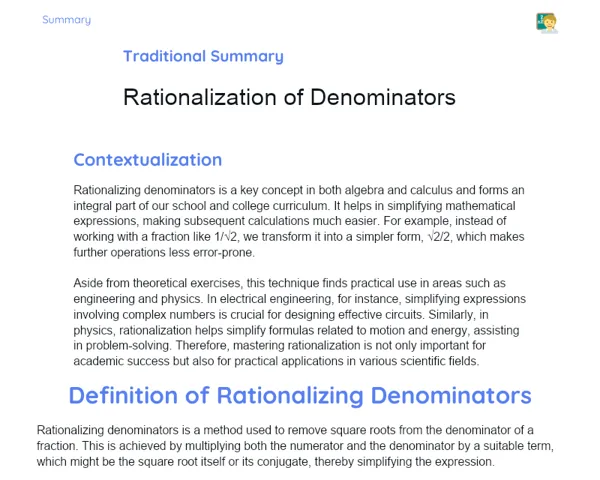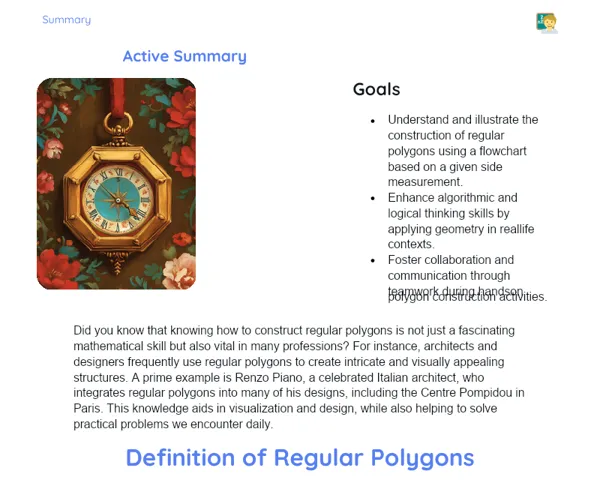Summary Tradisional | Perimeter: Circle
Contextualization
The perimeter of a geometric shape is essentially the distance around its outer edge. For a circle, this distance is referred to as the circumference. To find the circumference of a circle, we apply the formula P = 2πr, where 'P' denotes the perimeter, 'r' is the radius, and 'π' (pi) is a mathematical constant roughly equal to 3.14159. The radius is the measurement from the center of the circle to any point along its edge, while the diameter, which is double the radius, stretches from one side of the circle to the other, passing through the center.
The constant π stands out as one of the most intriguing and significant numbers in mathematics. It is not merely an approximation but an irrational number, meaning its decimal representation goes on forever without repeating. π is not just limited to circles; it is used across various scientific and engineering fields. Grasping its connection to the circumference is vital for numerous practical applications, ranging from measuring the circumference of circular objects to tackling complex issues in physics and architecture.
To Remember!
Definition of Perimeter in Circles
The perimeter of a circle, commonly called the circumference, refers to the distance measured around its edge. To compute this distance, we utilize the formula P = 2πr, where 'P' signifies the perimeter, 'r' denotes the radius of the circle, and 'π' (pi) is approximately 3.14159. The radius indicates the distance from the center to any point on the circle's edge. This relationship is rooted in the connection between the perimeter and the diameter, which itself is twice the radius.
Familiarity with the definition of circumference in circles is crucial for addressing geometric problems that involve circular shapes. For instance, to determine how much material is required to surround a circular flower bed, knowing the circumference is essential. Moreover, this formula finds application in various scientific and engineering domains, from constructing circular buildings to generating computer graphics and animations.
Everyday scenarios offer practical examples of this formula, such as measuring a pizza's edge or the circumference of a bicycle wheel. By understanding both the definition and formula of the perimeter, students will be better equipped to apply this knowledge in varied contexts and effectively solve mathematical challenges.
-
The perimeter of a circle is the measure around its edge.
-
The formula for calculating the perimeter is P = 2πr.
-
The radius is the distance from the center of the circle to any point on its edge.
Relationship Between Perimeter and Diameter
The relationship connecting the perimeter and diameter of a circle is one of the most critical and captivating aspects of geometry. This relationship is expressed through the formula P/D = π, where 'P' is the perimeter and 'D' is the diameter. In other words, the perimeter of any circle is always π times its diameter. Regardless of the circle's size, the ratio of perimeter to diameter will consistently be the constant π.
The diameter of a circle is simply twice the radius (D = 2r). Hence, we can rework the perimeter formula to P = 2πr by substituting the diameter with its radius equivalent. This relationship is foundational for understanding circle geometry and addressing problems involving circular measurements. For example, if we know the diameter of a circle, we can easily derive its perimeter using π.
This relationship has real-world implications in diverse areas, including civil engineering, where it plays a key role in the design and construction of circular infrastructures. Grasping the connection between perimeter and diameter empowers students to leverage this knowledge in practical scenarios and cultivate essential mathematical skills to handle complex challenges.
-
The ratio between the perimeter and diameter of a circle is always π.
-
The diameter is twice the radius (D = 2r).
-
The perimeter formula can be rewritten as P = 2πr.
Importance of the Value of π
The value of π, estimated at around 3.14159, is one of the most crucial constants in mathematics. Being an irrational number, it has a decimal expansion that continues infinitely without settling into a repeating pattern. This intriguing characteristic adds layers of mystery to π. The constant is prevalent in a multitude of mathematical and scientific equations, particularly those associated with circular and spherical structures.
Beyond geometry, π is foundational in various scientific and engineering domains. For instance, it appears in formulas that calculate the areas and volumes of three-dimensional shapes like spheres and cylinders. In physics, π figures into equations that explain wave behavior and fluid dynamics. Engineering designs, including bridges and tunnels, also rely heavily on π.
Recognizing the significance of π enables students to apply this knowledge in diverse situations, tackling complex challenges effectively. Additionally, familiarizing themselves with π and its irrational characteristics assists in developing advanced mathematical abilities, nurturing a genuine appreciation for the beauty and intricacies of mathematics.
-
π is an irrational number with infinite decimal places.
-
Approximately, π equals 3.14159.
-
π is utilized in various mathematical and scientific equations.
Practical Examples of Calculating the Perimeter
To reinforce the understanding of the perimeter calculation for a circle, engaging in practical examples helps illustrate the application of the formula P = 2πr. Let’s consider a circle with a radius of 3 cm. Using the formula, we compute the perimeter as P = 2π(3) = 6π. By substituting the approximate value of π, we find P ≈ 6 × 3.14159 = 18.85 cm. This straightforward example clearly demonstrates how the formula operates in determining circumference.
Another instance is a circle with a radius of 7 cm. Employing the formula, we find P = 2π(7) = 14π. With the estimated value of π, we obtain P ≈ 14 × 3.14159 = 43.98 cm. These examples emphasize that the perimeter of a circle is directly proportional to its radius and that the constant π plays a pivotal role in these calculations.
In addition to numerical illustrations, it's vital to look at real-life applications, such as measuring the circumference of circular items in our daily life, like a bottle cap or a bicycle wheel. Practical examples like these aid students in visualizing the application of theoretical concepts in tangible situations, enhancing the relevance and engagement in learning.
-
The formula P = 2πr is used to calculate the perimeter of a circle.
-
For example: For a circle with a radius of 3 cm, the perimeter is approximately 18.85 cm.
-
Real-world applications include measuring circular objects like caps and wheels.
Key Terms
-
Perimeter: The measure around the edge of a geometric figure.
-
Circle: A flat geometric figure where all points are at an equal distance (radius) from the center.
-
Radius: The distance from the center of the circle to any point on its edge.
-
Diameter: The length of a straight line that crosses the circle passing through the center, being double the radius.
-
π (pi): A mathematical constant approximately equal to 3.14159, which is the ratio between the perimeter of a circle and its diameter.
-
Irrational number: A number that cannot be expressed as a simple fraction and has infinite, non-repeating decimal places.
Important Conclusions
In this lesson, we delved into the concept of perimeter in circles, discovering that the distance encircling a circle is known as circumference, which can be computed using the formula P = 2πr. We examined the vital connection between the perimeter and diameter, noting that the ratio of these two measurements is consistently π, a mathematical constant close to 3.14159. We also highlighted the significance of the value of π, an irrational number with endless decimals, which holds immense importance in various mathematical and scientific contexts.
Through practical examples, like calculating the circumference of circles with differing radii, students could visualize the real-world application of the formula P = 2πr. We also covered the conversion between radius and diameter, clarifying that the diameter is twice the radius (D = 2r), simplifying computations when the diameter is known. Mastering these concepts is vital for solving geometric challenges and has practical significance across fields like engineering and physics.
By grasping the perimeter of a circle and recognizing the relevance of π, students can apply this knowledge in everyday scenarios, such as measuring circular items. This understanding lays the groundwork for developing mathematical skills and resolving complex problems, equipping students for future academic and practical hurdles. We encourage students to keep exploring this captivating subject and uncover its various applications.
Study Tips
-
Practice calculating the perimeter of different circular objects around you, like bottle caps, plates, and bicycle wheels. This will help solidify your understanding of the formula P = 2πr.
-
Review the relationships between radius, diameter, and perimeter. Make sure you understand how to convert these measurements and use π consistently in your calculations.
-
Explore more about the number π, its properties, and how it applies in other areas of mathematics and science. This will expand your understanding and appreciation for this important mathematical constant.



